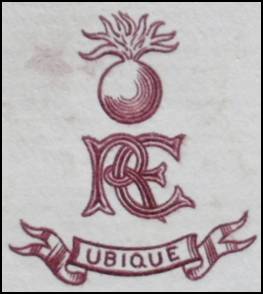
24411 (1852923) Sergeant
CHARLES WILLIAM RICHARD FOSTER
Royal Engineers
by
Lieutenant Colonel (Retired) Edward De Santis, MSCE, PE, MInstRE
U.S. Army Corps of Engineers
(January 2022)

Figure 1.
Royal Engineers Crest.
(Image courtesy of Stuart Gase)
1. INTRODUCTION
This study was initiated after the author acquired the
Army Long Service and Good Conduct Medal (GVR) with bar [REGULAR ARMY] that was
awarded to Sergeant Foster. The
information provided in this study was obtained from official Army records,
medal rolls, family trees, civil documents and The Sapper magazine (Journal of the Corps of Royal Engineers).
Every effort has been made to make Sergeant Fosterís story as accurate
as possible given the available resources.
NOTE: The
original study into the military service and life of Charles William Foster was
completed in 1998. This study was
revised in January 2022 as a result of information obtained from the Royal
Engineers Tracer Cards for this man that became available to the public in 2021.
Early Life
Charles William Richard Foster was born in the first quarter of 1895 at Southampton, Hampshire, the son of Walter Charles (1868-?) and Alice Emily (1870-?) Foster. The Fosters had three other children; Alice Hilda (1890-?), Ethel Maud (1891-?) and Percival Leslie (1902-1995). Family Information
The Foster family was residing in Southampton in 1901 when the census of England was taken. The composition of the household at that time is shown in the table below.
1901
Census of England and Wales
|
Address:
1 Ancaster Road (*), Southampton,
Hampshire |
|||||
|
Name
and Surname |
Relation |
Marital
Status |
Age |
Profession
or Occupation |
Birthplace |
|
Walter
Charles Foster |
Head |
Married |
32 |
Draughtsman |
Bedford,
Bedfordshire |
|
Alice
Emily Foster |
Wife |
Married |
31 |
|
Bedford,
Bedfordshire |
|
Alice
Hilda Foster |
Daughter |
|
11 |
|
Bedford,
Bedfordshire |
|
Ethel
Maud Foster |
Daughter |
|
10 |
|
Bedford,
Bedfordshire |
|
Charles
Richard Foster |
Son |
|
6 |
|
Southampton, |
|
Dorcas
Billing |
Cousin |
Widow |
59 |
|
Wortton,
Bedfordshire |
|
Archibald
Atkinson |
Visitor |
|
2 |
|
Brighton,
Sussex |
NOTE: (*) The name of this road has been changed from Ancaster to Ancasta.
By 1911 the address and composition of the Foster household had changed,
as shown in the table below.
1911
Census of England and Wales
|
Address:
13 Ancaster Road, Southampton, Hampshire |
|||||
|
Name
and Surname |
Relation |
Marital
Status |
Age |
Profession
or Occupation |
Birthplace |
|
Walter
Charles Foster |
Head |
Married |
42 |
Draughtsman, |
Bedford,
Bedfordshire |
|
Alice
Emily Foster |
Wife |
Married |
41 |
|
Bedford,
Bedfordshire |
|
Alice
Hilda Foster |
Daughter |
Single |
21 |
Shop
Assistant |
Bedford,
Bedfordshire |
|
Ethel
Maud Foster |
Daughter |
Single |
20 |
Dressmaker |
Bedford,
Bedfordshire |
|
Charles
Richard Foster |
Son |
Single |
16 |
Clerk, |
Southampton, |
|
Percival
Leslie Foster |
Son |
|
9 |
|
Southampton, |
|
Dorcas
Billing |
Cousin |
Widow |
69 |
|
Wortton,
Bedfordshire |
Since Sergeant Fosterís military records were not obtained for this study, no physical description of him was available. However, his service papers may be available from the Army Personnel Centre in Glasgow, and attempts to retrieve those papers may be made in the future.
4. ENLISTMENT AND
TRAINING
Enlistment
Charles Foster enlisted in the Royal Engineers as a Sapper on 10 April of 1913 for a period of 12 years with the Colours. He was assigned Regimental Number 24411 upon his enlistment.[1] Foster would have been well suited for enlistment in the Royal Engineers as his civilian occupation was Clerk at the Ordnance Survey, the map makers of Great Britain. His father also worked for the Ordnance Survey as a Draughtsman, so Charles surely developed some skills in this area from his dad. The Royal Engineers would have been eager to have young Charles in one of it Field Survey Companies and although his records are not specific in this required, it is almost guaranteed that he was posted to one such company after his recruit training. In fact, his R.E. Tracer card shows that his Corps Trade was Surveyor when he enlisted. Following the certification of his enlistment he was almost immediately posted to the School of Military Engineering at Chatham, Kent where he received training as an engineer soldier.
Training
Fosterís training began with the basics that were required for each man
to learn to be a soldier. This
involved military customs, the wearing of his uniform and insignia, military
discipline and the use, care and maintenance of his weapon, the short, magazine
Lee-Enfield rifle (SMLE). Following
a period of basic training, Foster then received the training necessary to make
him an engineer soldier. This
involved such field engineering subjects as tunnelling, trench-building,
camouflaging techniques, barbed-wire entanglements, construction and clearing of
obstacles, bridging, explosives and demolitions and other skills necessary to
support the infantry and artillery in the field.
Following his recruit training, Foster may have received additional
training sufficient to qualify him as a Surveyor.[2]
5.
POSTINGS AND CAMPAIGN SERVICE
Egyptian
Expeditionary Force (1915-1918)
Following his training, Foster was posted to a unit of the Royal Engineers and was sent to Egypt with that unit on 24 August 1915.[3] Without access to his Great War service papers it is not possible to know precisely to which unit he was assigned; however, some very good information regarding Field Survey Companies is provided in the Long, Long Trail web site[4] and in A Short History of 13 Field Survey Squadron, Royal Engineers. From the Long, Long Trail web site we learn of the pre-war regular Field Survey Companies of the Royal Engineer, as shown in the table below.
|
Company |
Notes |
|
13th
Survey Company |
Split into half-companies on mobilisation, the men were sent to
coastal garrisons. Once relieved of those duties by Territorial Force
units, the company came back and was converted to become the 13th
Base Park Company, R.E.. This company was posted to Egypt. |
|
14th
Survey Company |
Split into half-companies on mobilisation, the men were sent to
coastal garrisons. Once relieved of those duties by Territorial Force
units, the company came back and was converted to become two Army Troops
Companies (one being 37th Army Troop Company, R.E.) for service
in Egypt. |
|
19th
Survey Company |
Half of this unit was converted to become the 46th Advanced
Park Company, R.E. and was sent to Egypt.
The remainder stayed in England and was based at Southampton,
becoming a depot unit for all other Field Survey units. |
The 13th Survey Company, R.E. was remobilized at Pembroke on 13 April 1915 as the 13th Base Park Company, R.E. (Mediterranean) totaling 78 personnel. Later in April 1915 the company, under the command of Major Edward Newman Mozley, R.E.,[5] embarked at Plymouth and sailed for Alexandria, arriving two weeks later. On 16 May 1915 the company re-embarked for Gallipoli, landing on 'W' Beach, Cape Helles, on 19 May 1915. Shortly afterwards Major Mozley was posted as CRE to an Australian Division and Major P.H. Campbell, R.E. assumed command on 1 June 1915.
The company was employed mainly in the lighterage of equipment from store-ships in the bay, but enemy shellfire and submarine activity necessitated moving the Base Park first to Imbros and finally to Mudros. It is recorded that a small detachment of 12 men left on 'W' Beach until August 1915 suffered 6 killed and 3 wounded from shellfire. At Mudros an R.E. Pier was built in August 1915 and this greatly helped the unit's task of boat ferrying stores to Helles, Imbros, Anzac and Suvla Beaches. During this time the unit strength was greatly depleted due to sickness, falling at one time to 42 all ranks. Foster embarked for Egypt on 24 August 1915, so he may well have been part of a draft designated to replace the casualties suffered by the company that month.
On 29 January 1916 the company disembarked at Alexandria from Mudros and Lieutenant W.M. Jennings, R.E. who had been with the company at Gallipoli, assumed command. The Base Park was established at Alexandria and the company now greatly reinforced was kept very busy moving stores by ship and rail. During February and March 1916 the average daily handling of material was 885 tons, this was made possible by the provision of large working parties from the Egyptian Labour Corps.
In April 1916 a Workshop of 2 Officers and 52 men was added to the establishment, this was kept extremely busy providing base workshop facilities at Alexandria. Major Jennings handed over the company to Captain D.A. Law RE in October 1917; he commanded briefly until the arrival of Major W.E. Francis, R.E. on 19 November 1917. Major Francis relinquished command in October 1919, by which time the company strength was gradually being run down; the name of his successor is not recorded.
The company remained at Alexandria as a Base Park until 6 April 1920 when the war diary closed and it is assumed that the company disbanded on that date.[6] This date of 6 April 1920, when the 13th Base Park Company may have been disbanded, coincides very closely with Fosterís posting to the 13th Field Survey Company on 30 June 1920. In fact, the 13th Base Park Company may not have been ďdisbanded,Ē but reformed as a Field Survey Company.
For his service during the war he was awarded the 1914-15 Star, British War Medal and Victory Medal.[7] The roll below shows Fosterís entitlement to the 1914-15 Star medal based on his date of embarkation for service abroad of 24 August 1915. The notation (3) indicates that the theatre of war to which he was posted was Egypt.
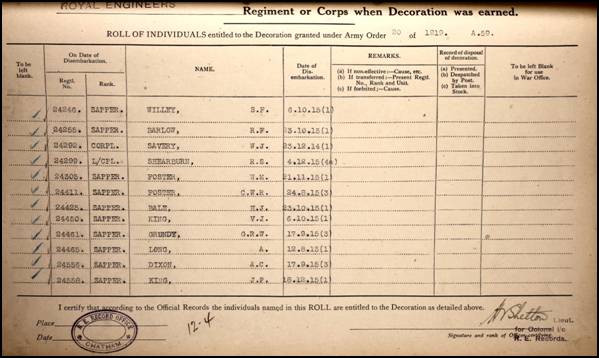
Figure 2. A Page from the
Royal Engineers Medal Roll for the 1914-15 Star.
(Image courtesy of Ancestry.com)
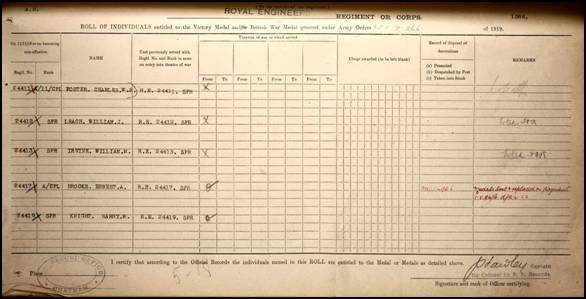
Figure 3. A Page from the
Royal Engineers Medal Roll for
the British War Medal and Victory Medal.
(Image courtesy of Ancestry.com)
The medals granted to Foster on this roll were issued after the end of the Great War. The roll shows that Foster was a 2nd Corporal when the war ended.
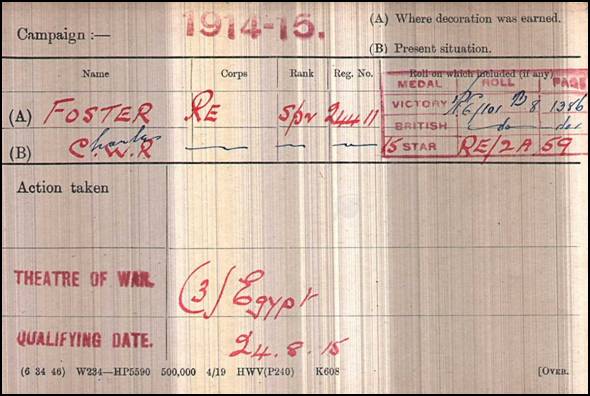
Figure 4. The Great War
Medal Index Card (MIC) of C.W.R. Foster.
(Image courtesy of Ancestry.com)
The Medal Index Card summarizes Fosterís entitlement to his Great War medals. Although his rank is shown as Sapper on the MIC, Figure 3 indicates that he was a 2nd Corporal at the warís end. The theatre of war to which he was sent and the date that he embarked for Egypt are clearly shown on the card. The medal roll designations in the red boxes provide the roll numbers and pages on which his name appears.
Figure 5 shows the three medals mentioned above to which Foster was entitled for his service in the Great War. The medals shown are not Fosterís medals, as his medals are not in the authorís collection and their whereabouts is unknown.
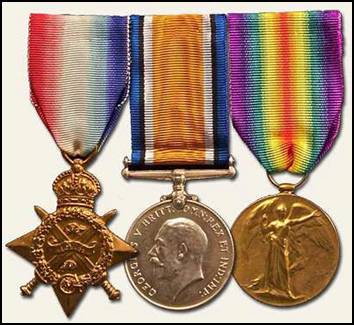
Figure 5. The Great War Trio
of Medals.
(Photograph from the authorís collection)
York
(1920-1921)
Foster remained in the Army after the war and was issued Army Number 1852923. On 30 June 1920 he was posted to the 13th Survey Company, R.E. and on 22 September 1920 he was promoted to Corporal. He was assigned to various surveying duties with the company in the northern part of England.
At the end of the Great War the field survey units which had developed during the war were disbanded and the regular personnel returned to duty with the Ordnance Survey. At that time the members of the company were no doubt well scattered on survey work in the north of England and only came together for their annual military training.[8] Foster remained with the 13th Survey Company until 29 September 1921 when he was posted to the 19th Survey Company at Fort Southwick.
Fort
Southwick, near Fareham (1921-1925)
Foster was promoted to the rank of Lance Sergeant on 22 March 1922 while serving with the 19th Survey Company and on 28 April 1924 he re-enlisted to complete 21 years with the Colours.[9] On 4 March 1925 he was promoted to the rank of Sergeant on the Survey Roster of the Royal Engineers.[10]
Fareham is a town at the northwest tip of Portsmouth Harbour, between the cities of Portsmouth and Southampton in south east Hampshire. The 19th Survey Company was stationed here as Southampton was the location of what would soon become the headquarters of the Survey Battalion and the Ordnance Survey. Sergeant Fosterís stay with the 19th Survey Company was a relatively short one, as he was selected to take part in a survey of lands in East Africa.
British
East Africa (1925-1927)
The Pact of London of 1915 heralded Italy into the Great War as a British
ally, and it was the natural outcome of this alliance that the fruits of victory
should be shared. In due course it was decided that, in lieu of acquiring an
actual portion of conquered territory, Italy should receive the Province of
Jubaland, to be taken from the Colony and Protectorate of Kenya. The cession
took place on 29 June 1925, and was signaled by the change of the national flags
at Kismayu on that day. For exactly a year from the date of cession Jubaland,
renamed Oltre-Giuba, existed and flourished as a separate Italian colony under
the High Commissionership of H.E. Corrado Zoli. Road construction and building
advanced apace, and many great improvements were worked in Kismayu. On 29 June
1926 the colony was absorbed by Italian Somaliland and completely lost its
entity in a number of pre-existent provinces. The authority for the cession of
Jubaland was the Anglo-Italian Treaty of 15 July 1924, ratified by Parliament on
27 March 1925. Under Article 12 of this treaty there was authorized the
appointment of an Anglo-Italian Commission, later known as the Jubaland
Commission, with power to investigate and decide certain matters specifically
stated in the treaty, and also to decide generally on the manner in which the
treaty should be put into force. The Jubaland Boundary Commission did not
receive its charter directly from the treaty, but was naturally a servant of the
Jubaland Commission, owing allegiance to it in all matters regarding
delimitation, survey, and demarcation of the boundary.
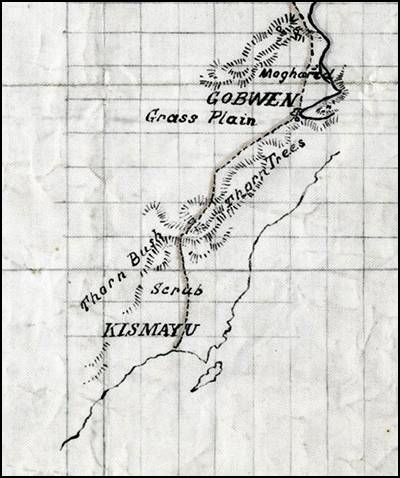
Figure 6. A Sketch Map of
Kismayu.
(Image courtesy of Wikipedia)
It was decided that the boundary of was to run from the confluence of the rivers Ganale and Daua, along the course of the Daua upstream to the southern point of the small southerly bend of the latter river in the vicinity of Malka Re; thence in a southwesterly direction. Once the boundary was decided upon an Anglo-Italian Jubaland Boundary Commission was established and officers and men of the Ordnance Survey were designated to perform the job of surveying the boundary. Sergeant Foster was one of the surveyors chosen to accomplish this work and on 18 April 1925 he proceeded to British East Africa. After two years working on this survey he returned home and was posted again to the 19th Survey Company at Southampton.
Southampton
(1927-1929)
The Union Castle Mail Steamship Company passenger list for Grantully Castle indicates that Foster arrived in London on 29 April 1927 having come from Capetown by way of East African ports and Suez. By this time the 19th Survey Company had left Fort Southwick and was at Southampton where the Ordnance Survey was centralizing its operations and forming a Survey Battalion. The Director-General of Survey was Brigadier Edward M. Jack, CB, CMG, DSO. Foster served in the 19th Survey Company for about two years before the Survey Battalion was formed at Southampton.
Survey
Battalion (1929-1934)
A short history of the formation of the Survey Battalion makes a fitting addition to Fosterís story. In 1824, a select committee of the House of Commons recommended a survey and valuation of Ireland at the scale of six inches to a mile. Survey work in England and Scotland then ceased until 1840. A regular and disciplined labour force was provided by the formation in 1824 and 1825 of three survey companies, the 13th, 14th and 16th Companies of Royal Sappers and Miners. Another company, the 19th, was formed in 1848, and all four were transferred to the Royal Engineers, from which their officers came, in 1856. The 16th Company was disbanded in 1906, and the remainder reconstituted as the Survey Battalion, R.E. in 1929. Foster was among the men who joined the Survey Battalion when it was first organized.
6.
RELEASE FROM SERVICE
Sergeant Fosterís total service with the Royal Engineers was reckoned as shown in the tables below.
Location |
Period
of Service |
|
Chatham |
10 April 1913 Ė 23 August 1915 |
|
Egypt |
24 August 1915 Ė 6 April 1920 |
|
Home (war leave) |
7 April 1920 Ė 29 June 1920 |
|
York |
30 June 1920 Ė 28 September 1921 |
|
Fort Southwick |
29 September 1921 Ė 17 April 1925 |
|
British East Africa |
18 April 1925 Ė 25 July 1927 |
|
Southampton |
26 July 1927 Ė 9 April 1934 |
Location |
Period
of Service |
|
Home |
14 years, 1 month and 8 days |
|
Abroad |
6 years, 10 months and 22 days |
|
Total Service |
21 years |
The following sections are presented in tabular form to summarize Sergeant Fosterís promotions, appointments, military training and qualifications and the medals that he was awarded during his time in the Army. They are provided to give the reader easy access to these aspects of his military career. The tables are followed by sections dealing with his marriage, personal information and post-service life.
7.
PROMOTIONS AND APPOINTMENTS
Sergeant Foster received the following promotions during his time in service:
Date of Promotion or Appointment |
|
|
April 1913 |
Sapper, upon enlistment in the Royal Engineers. |
|
About 1916 |
Promoted Lance Corporal. |
|
About 1918 |
Promoted 2nd Corporal. |
|
22 September 1920 |
Promoted Corporal. |
|
22 March 1922 |
Promoted Lance Sergeant. |
|
4 March 1925 |
Promoted Sergeant |
8.
MEDALS, AWARDS AND DECORATIONS
In April of 1931 Foster completed 18 years of service with the Colours making him eligible to receive the Army Long Service and Good Conduct Medal (GVR) with bar [REGULAR ARMY]. [11] The medal is named to him in impressed upper case letters as follows:
1852923 SJT. C.W.R.
FOSTER. R.E.
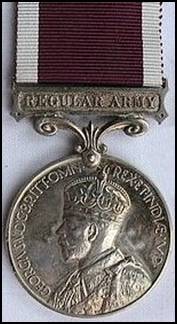
Figure
7. The
Army Long Service and Good Conduct Medal
of Sergeant C.W.R. Foster, Royal Engineers
(Photograph from the authorís collection)
9. POST SERVICE LIFE
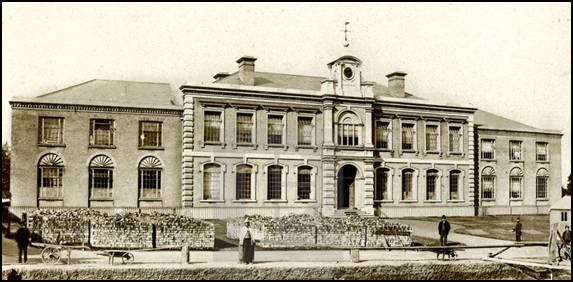
Figure 8. The Ordnance
Survey Office Building, pre-1940.
(Photograph courtesy of reddit.com)
Sergeant Foster was discharged from the Army on 9 April 1934 after completing 21 years of service.[12] After his retirement he took a position at the Ordnance Survey Office in Southampton. The Ordnance Survey Office in Southampton was located on London Road. The building shown in Figure 7 above was demolished in 1940 after being bombed by German aircraft.
This job was a natural for him after spending most of his career on survey duties with the Royal Engineers. He became a Supervisor with the Ordnance Survey and remained in this position until his retirement. The London Gazette indicates that he was a Civil Assistant on the Ordnance Survey for the Ministry of Agriculture and Fisheries.[13] He was selected for this position without competition, meaning that he was selected for the position based on his skill and prior experience gained while serving in the Royal Engineers.
While working for the Ordnance Survey, he and his wife resided at 27 Livingstone Road in Southampton.[14] Their residence was located in the Portswood section of the city, just south of the intersection of Livingstone Road and Gordon Avenue.
On 26 September 1952, Foster prepared his last will and testament. His estate was willed to his wife, V. Bessie Foster, who was living at the 27 Livingstone Road address.[15] The preparation of the will was witnessed by Mr. Walter Reginald South of 105 King Edward Avenue, Southampton, and by Mr. John Armine Morris Robertson of 5 Capon Close, Swaythling, Southampton.[16]
The Fosters continued to reside in Southampton after Charlesís retirement from the Ordnance Survey. Charles William Richard Foster died on 6 March 1960 at the age of 65 years and 4 months. His death certificate indicates the causes of death as:
a) coronary artery occlusion, and
b) chronic bronchitis.
His death was certified by James G. Scott, M.B.[17]
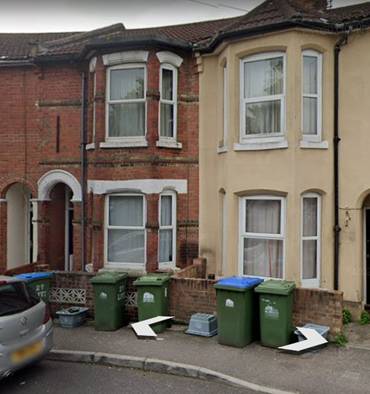
Figure 9. The Foster
Residence (red brick) at 27 Livingstone Road, Southampton.
(Photograph courtesy of Google Earth)
The informant of his death was his son, John Foster, of Hunsley, Bagshot Road, Woking, Surrey.[18] His death was registered in Southampton on 7 March 1960 by K.J. Sheppard, Registrar of the Southampton Registration District.
Charlesí will was filed for probate in Winchester on 13 April 1960. His effects, amounting to £2113-15s (approximately $66,700 US in 2021 currency) were left to his widow.
10.
MARRIAGE, FAMILY AND PERSONAL INFORMATION
Spouse
Charles William Richard Foster married Vida Bessie Dear (1890-1992) in the Parish Church of Wyke Regis, Dorsetshire on 26 December 1921. Their marriage certificate indicates that Charles was a 27-year old soldier assigned to the Ordnance Survey Office in Southampton. His father is shown on the document as Walter Charles Foster, a Draughtsman.
The fact that Foster stated that he was assigned to the Ordnance Survey Office in 1921 when he was married is interesting. He had been assigned to the 19th Survey Company on 29 September 1921;[19] hence, it may be assumed that some men of the company also were working at the Ordnance Survey Office at the time.
Vida Bessie Dear, a 30-year old Spinster, was the daughter of Thomas Dear (1863-1931), a Gardiner. At the time of the marriage Vida was residing at Rose Cottage in Wyke Regis. Charles and Vida were married by E. de B. Thurston, the Rector of the parish church and the marriage was witnessed by Thomas Dear, Vidaís father and Charlesí mother, Alice Emily Foster.
Vida Bessie Foster died at Stevenage, Hertfordshire in January 1992 at the age of 101 years.
Parents
Little is known about Fosterís parents other than what was found in
various census documents. His
father, Walter Charles Foster was born in Bedford, Bedforshire in July of 1868
and became a Draughtman by trade. In
1881 he was residing in St. Peterís Parish in Bedforshire.
In 1890 he married a woman whose given names were Alice Emily (surname
unknown).
Siblings
Charles sister, Alice Hilda Foster, was born in January 1890 in Bedford, Bedfordshire. It appears that she married one Thomas John Eaton on 28 June 1914 at St Mary The Virgin Church in Walthamstow, Essex. She was living at 200 Murchison Road in Essex when apparently she was killed on 8 August 1944.[20] She was 57 years old and may have been killed as the result of German bombing.
On the page where Aliceís death is noted in the Commonwealth War Graves Commission memorial book for Leyton, Essex (a town in east London) there are 28 additional entries listing deaths due to the German bombings in the London area between 1940 and 1944. One of the saddest of these entries is the following:
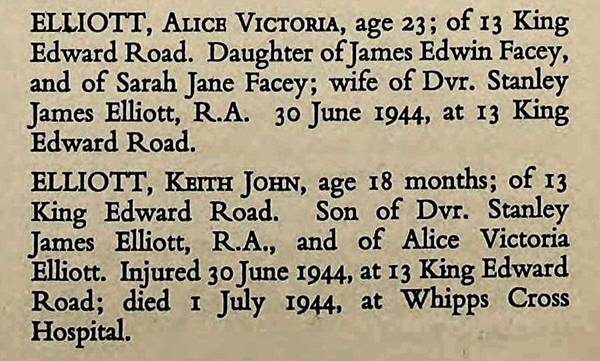
Figure 10.
Announcement of the Death of a Mother and Child Killed on King Edward
Road in Leyton during the German Blitz.
(Image courtesy of the Commonwealth War Graves Commission)
Here we see the 23-year old wife and 18-month old son of a Driver in the Royal Artillery both killed as a result of a bombing on 30 June 1944.
Fosterís other sister, Ethel Maud Foster, was born about 1891, also in Bedford. It appears that Ethel may have remained a spinster all her life. Her date of death is unknown.
Charlesí brother, Percival Leslie Foster, was born in Southampton on 16 March 1902. Percy died in November 1995 at Southampton at the age of 93.
REFERENCES:
Census
Documents
1.
England
and Wales Birth Index, 1837-1915, Births Registered Jan-Feb-Mar 1895.
.
2.
Marriage
Certificate, The Parish Church, Wyke Regis, Dorset, 26 December 1921.
.
3.
Certified
copy of the Last Will and Testament of Charles William Richard Foster, dated 26
September 1952.
.
4.
Certified Copy
and an Entry of Death, DXZ 504243, General Register Office, London, dated 29
July 1998.
.
5.
England
and Wales Death Index, 1916-2007, Deaths Registered January 1960.
.
6.
Probate
Calendar, 1960, p. 431.
.
7.
World
War 2 Civilian Deaths, 1939-1945, Essex, p. 330; Alice Hilda Eaton.
.
8.
Royal
Engineers Tracer Cards.
.
9.
KING,
L.N. Work of the Jubaland Boundary Commission
Family
Trees
Internet
Web Sites
https://en.wikipedia.org/wiki/Egyptian_Expeditionary_Force
https://www.longlongtrail.co.uk/battles/the-campaign-in-egypt-and-palestine/
http://www.militarysurvey.org.uk/Historic%20Archive/Units/13/A%20Short%20history%20of%2013.htm
https://www.reddit.com/r/Southampton/comments/k8fpux/ordnance_survey_office/
London Gazette
The London Gazette, 8 June 1934,
p. 3672.
Medal
Rolls and Index Card
Periodicals
Ship ManifestsGrantully Castle, Capetown to London, 29 April 1927.
ENDNOTES:
[1] R.E. Tracer Card.
[2] Ibid.
[3] Medal Index Card.
[4] https://www.longlongtrail.co.uk/army/regiments-and-corps/the-corps-of-royal-engineers-in-the-first-world-war/the-field-survey-companies-of-the-royal-engineers/
[5] Later, Lieutenant Colonel, DSO.
[6] A Short History of 13 Field Survey Squadron, Royal Engineers
[7] Medal Index Card.
[8] Short History of 13 Field Squadron.
[9] R.E. Tracer Card.
[10] The Sapper, February 1931 and February 1933.
[11] This medal is in the authorís collection.
[12] The Sapper, May 1934.
[13] The London Gazette, 8 June 1934, p. 3672.
[14] Certified Copy and an Entry of Death, DXZ 504243, General Register Office, London, dated 29 July 1998.
[15] Mrs. Fosterís first given name is hand-written in the will, but unfortunately it is not legible.
[16] Certified copy of the Last Will and Testament of Charles William Richard Foster, dated 26 September 1952.
[17] M.B.: Bachelor of Medicine.
[18] It is not known whether the Fosters had any other children besides their son John.
[19] R.E. Tracer Card.
[20] World War 2 Civilian Deaths, 1939-1945, Essex, p. 330.